Table of Contents
There are 16 species of native or nearly native Johnston City, TN milkweeds (Asclepias spp.) that can be grown for butterflies and other insects. Milkweeds are an important host species for monarch butterflies in Tennessee. The monarch butterfly in particular uses the cardenolides found in the milky sap of milkweeds to give an unpleasant taste to predators. These plants are also an important nectar source to all insects visiting your pollinator garden.
General Information about Native Plant and Pollinator Gardens
When planting a native plant and pollinator garden in Johnson City, TN, you need to ensure that you have a selection of plants that provide blooms at different times of the year. Plants need to be spaced in order to provide for adequate air circulation and sunlight penetration. In addition to the plants, you need to provide a source of water such as a birdbath or water feature, shelter for animals, and nesting locations for birds. Be sure to also include plants of different heights for perching. Resources you can use for more information on butterfly gardening in Johnson City, TN include University of Tennessee Extension, Tennessee Native Plant Society, and local plant nurseries and garden centers.
Location of Johnston City, Tennessee

Johnson City is located in northeast Tennessee. Johnston City is located mostly in Washington County, but also encompasses parts of Carter and Sullivan Counties.
USDA Plant Hardiness Zones in Johnson City, Tennessee

Johnson City, TN is located within Plant Hardiness Zones 7a and 7b. When selecting plants in Johnson City you will want to get those that can handle temperatures as cold as 00F.
Butterflies in Johnson City, TN that are Hosted by Milkweeds (Asclepias spp.)

Monarch Butterfly (Danaus plexippus)
The monarch butterfly is an iconic butterfly in North America and is a bell-weather of the environment. Having a distinctive orange color with black stripes, this butterfly has a wingspan of 3 in (7.6 cm) to 5 in (12.7 cm). The monarch butterfly uses milkweed to get cardenolides, a toxin that is distasteful to predators. This butterfly can have several flights a year and is known for its migrations to Mexico each year. However, some populations in California, Arizona, and Florida do not migrate and breed year-round (Urguhart, et al 1968).
List of Milkweeds that are Native or Nearly Native in the Johnson City, TN Area
1. Clasping Milkweed (Asclepias amplexicaulis), a Milkweed for Moist to Dry Soils
Clasping milkweed is found in open to semi-open places such as meadows, savannas, woodlands, and roadsides. While it likes full sun, this plant can handle part-shade and needs clay, loam, or sandy soil that is well-drained. Reproduction is through seeds and underground rhizomes. The pink to purple flower clusters have about 25 fragrant flowers each.
Some companion plants to clasping milkweed that can grow in Johnson City in the same conditions and maximize pollinator diversity include:
- Little Bluestem (Schizachyrium scoparium): provides some structural diversity to the garden and creates shelter for different species of insects during the entire year.
- Purple Coneflower (Echinacea purpurea): a magnet for all kinds of pollinators including bees and butterflies.
- Aromatic Aster (Symphyotrichum oblongifolium): has late season blooms and gives food for late season butterflies.
- Prairie Coreopsis (Coreopsis palmata): has bright yellow flowers that contrast with the milkweed and provides nectar for native bees.
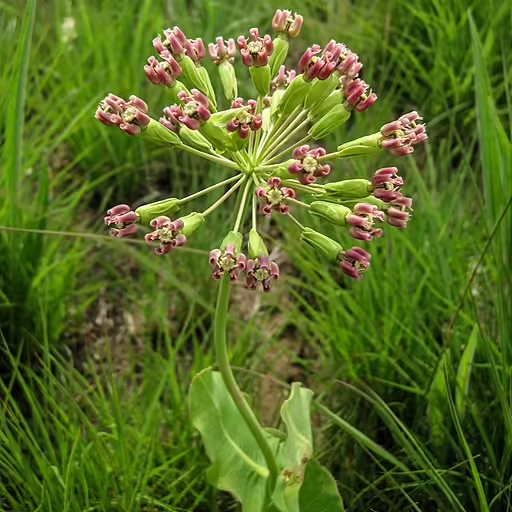
Facts about Clasping Milkweed
- Native to Tennessee: Yes, throughout except for central counties (Kartesz 2015)
- Native to Johnson City: No
- Natural Habitat: dry woodlands, meadows, and roadsides
- Height: up to 3 ft (0.9 m)
- Flower Color: greenish-pink, red, brown, to purple
- Flowering Period: March to September
- USDA Hardiness Zone: 3-9
Gardening with Clasping Milkweed
In your Johnson City, TN butterfly garden, this milkweed needs full sun to part-shade and moist to dry soils.
2. Poke Milkweed (Asclepias exaltata), a Milkweed for Shade and Moist Soils
Poke milkweed is a part-shade to shade loving milkweed, but can handle full sun in a garden setting. A variety of soils such as clay, loamy, and sand that are consistently moderate to wet and are well-drained are needed. The leaves of this milkweed are notable for being dark green with purplish veins. It is important to consider the size of each plant in order to reduce overcrowding.
Some companion plants to poke milkweed that can grow in Johnson City in the same conditions and maximize pollinator diversity include:
- Wild Ginger (Asarum canadense): a shade loving ground cover that attracts early ground pollinators such as beetles.
- Jacob’s Ladder (Polemonium reptans): this species has delicate blue flowers, attracts bees, and provides an early pollen source.
- Virginia Bluebells (Mertensia virginica): a spring ephemeral that is an early nectar source for bees and butterflies.
- Eastern Columbine (Aquilegia canadensis): this red flowered species attracts hummingbirds and long-tongued bees.
- Solomon’s Seal (Polygonatum biflorum): this species is tolerant of shade and attracts a number of pollinators.
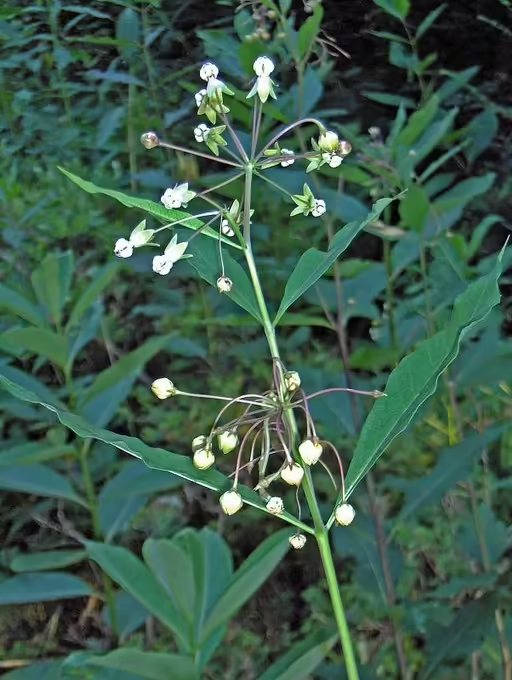
Facts about Poke Milkweed
- Native to Tennessee: Yes, central and eastern counties (Kartesz 2015)
- Native to Johnson City: Yes, in Carter County
- Natural Habitat: moist woods, roadsides, and edges of woods
- Height: 2 ft (0.6 m) to 6 ft (1.8 m)
- Flower Color: white to green with accents of rose, purple, or blue
- Flowering Period: May to August
- USDA Hardiness Zone: 3-9
Gardening with Poke Milkweed
In your Johnson City, TN butterfly garden, this milkweed needs part-shade to full shade and moist soil.
3. Swamp Milkweed (Asclepias incarnata), a Milkweed for Moist Soils
Swamp milkweed likes wet soils in full sun or partial shade and can be another companion to poke milkweed in shady conditions. However, in a garden setting, this species can handle drier conditions. Swamp milkweed is a fairly tall milkweed, needs space to spread out, and is fairly low maintenance. However, it needs consistent moisture to thrive. The fragrant pink flowers are a magnet for bees and other insects.
Some companion plants to swamp milkweed that can grow in Johnson City in the same conditions and maximize pollinator diversity include:
- Joe-Pye Weed (Eutrochium spp.): a tall plant that provides late-season blooms and attracts bees and butterflies.
- Cardinal Flower (Lobelia cardinalis): this species has brilliant red flowers that attract hummingbirds and butterflies.
- Blue Vervain (Verbena hastata): this plant has tall blue flower spikes that attract a number of pollinators.
- Ironweed (Vernonia spp.): This plant with purplish flowers provides late season blooms.
- Goldenrods (Solidago spp.): goldenrods generally have yellow to white flowers that provide late-season nectar.
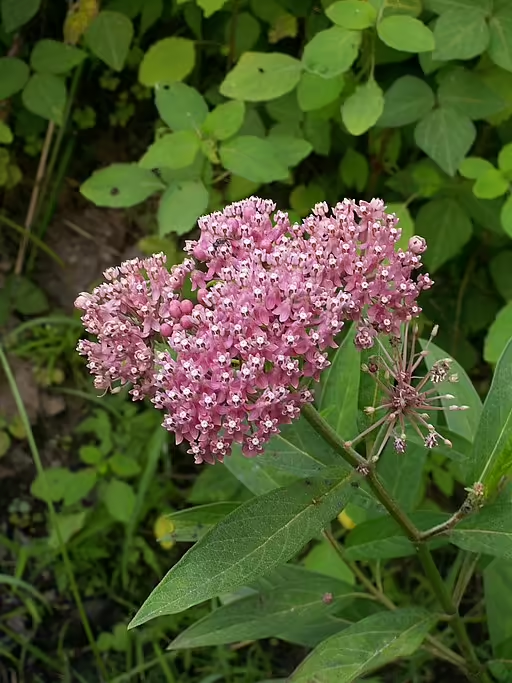
Facts about Swamp Milkweed
Asclepias incarnata subsp. incarnata and spp. pulchra in Tennessee
- Native to Tennessee: Yes, eastern counties – pulchra, scattered throughout – incarnata (Kartesz 2015)
- Native to Johnson City: Yes, incarnata
- Natural Habitat: shores of streams, lakes, ponds, and other wetlands
- Height: 3 ft (0.9 m) to 5 ft (1.5 m)
- Flower Color: pink or red
- Flowering Period: July to September
- USDA Hardiness Zone: 3-9
Gardening with Swamp Milkweed
In your Johnson City, TN butterfly garden, this milkweed needs full sun to partial shade and medium to moist soil.
4. Few-flower Milkweed (Asclepias lanceolata), a Milkweed for Moist Soils
Few-flower milkweed grows in the coastal areas of the southeastern United States. While not native to Tennessee or Johnson City, this milkweed can handle the plant hardiness zone and likes consistent moist to wet soils that are acidic in full sun to part-shade. If your soil is not acidic enough it can be amended with peat moss. Along with butterfly weed, this is one of two orange-colored milkweeds you can grow in the area.
Some companion plants to few-flowered milkweed that can grow in Johnson City in the same conditions and maximize pollinator diversity include:
- Virginia Sweetspire (Itea virginica): a shrub that can handle moist acidic soils, has fragrant flowers, and fall color interest.
- Swamp Azalea (Rhododendron viscosum): a native azalea that thrives in moist acidic soil and has fragrant soils.
- Pitcher Plants (Sarracenia spp.): these unique carnivorous plants can handle acidic boggy conditions.
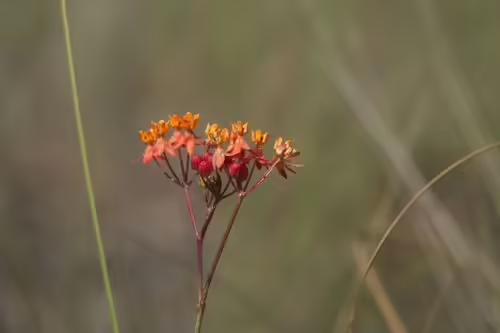
Facts about Few-flower Milkweed
- Native to Tennessee: No (Kartesz 2015)
- Native to Johnson City: No
- Natural Habitat: edges of marshes and wet areas of pine barrens and savannas
- Height: 2 ft (0.6 m) to 5 ft (1.5 m)
- Flower Color: yellow, orange, red
- Flowering Period: May to August
- USDA Hardiness Zone: 5-11
Gardening with Few-flower Milkweed
In your Johnson City, TN butterfly garden, this milkweed needs full sun to part-shade and loamy moist to wet soil.
5. Long-leaf Milkweed (Asclepias longifolia), a Milkweed for Sandy Soils
Long-leaf milkweed is another wet soil lover that has a scattered distribution in central Tennessee. While not native to the Johnson City area, this plant can handle the plant hardiness zone of the city. This species should be placed in full sun and in sandy soils that are well-drained.
Some companion plants to long-leaf milkweed that can grow in Johnson City in the same conditions and maximize pollinator diversity include:
- Eastern Prickly Pear Cactus (Opuntia humifusa): a succulent that likes sandy soils and provides food for native insects.
- Sand Coreopsis (Coreopsis villosa): this Coreopsis species is adapted to sandy soils and has bright yellow flowers.
- Downy Wood Mint (Blephilia ciliata): this member of the mints thrives in dry open woods in sandy soil.
- Cardinal Flower (Lobelia cardinalis): this species has brilliant red flowers that attract hummingbirds and butterflies.
- Pennsylvania Sedge (Carex pensylvanica): this sedge is a mounding groundcover that can handle sandy conditions.
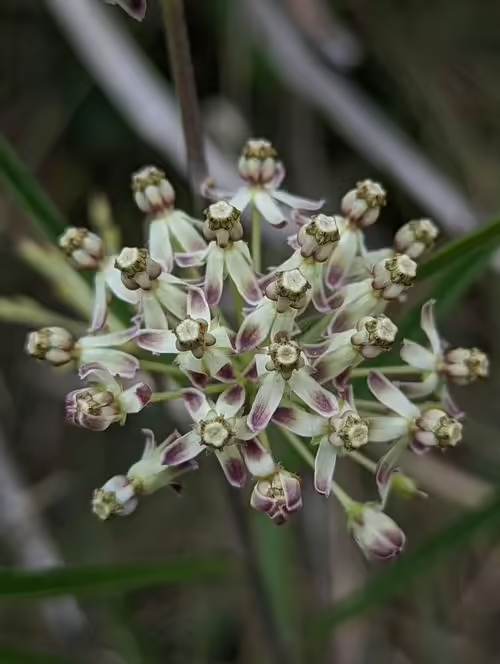
Facts about Long-leaf Milkweed
Asclepias longifolia var. hirtella in Tennessee
- Native to Tennessee: Yes, scattered in central counties (Kartesz 2015)
- Native to Johnson City: No
- Natural Habitat: bogs, swamps, and wet flatwoods
- Height: 1 ft (0.3 m) to 2.5 ft (0.8 m)
- Flower Color: greenish-white with a tinge of purple
- Flowering Period: April to July
- USDA Hardiness Zone: 4-9
Gardening with Long-leaf Milkweed
In your Johnson City, TN butterfly garden, this milkweed needs full sun and moist to wet soils.
6. Purple Milkweed (Asclepias purpurascens), a Milkweed for Medium to Moist Soils
If you are looking for a splash of purple in your garden while hosting the monarch butterflies, this milkweed may be for you. In the wild this species is found in moist soils, but can grow in medium well-drained soils in a garden and can even tolerate droughts, if established. Be sure to have plenty of space for this plant, as it likes to spread and form colonies.
Some companion plants to purple milkweed that can grow in Johnson City in the same conditions and maximize pollinator diversity include:
- Blue Mistflower (Conoclinum coelestinum): a plant with blue colored flowers that provides late season blooms and likes part-shade.
- Smooth Blue Aster (Symphyotrichum laeve): a late blooming aster that attracts pollinators and handles some shade.
- Black Cohosh (Actaea racemosa): a plant with tall white flower spikes that attracts pollinators in light shade conditions.
- Golden Alexander (Zizia aurea): an early yellow flowering plant that is a host to the black swallowtail butterfly.
- Wild Geranium (Geranium maculatum): an early spring plant that grows in shade and attracts pollinators.
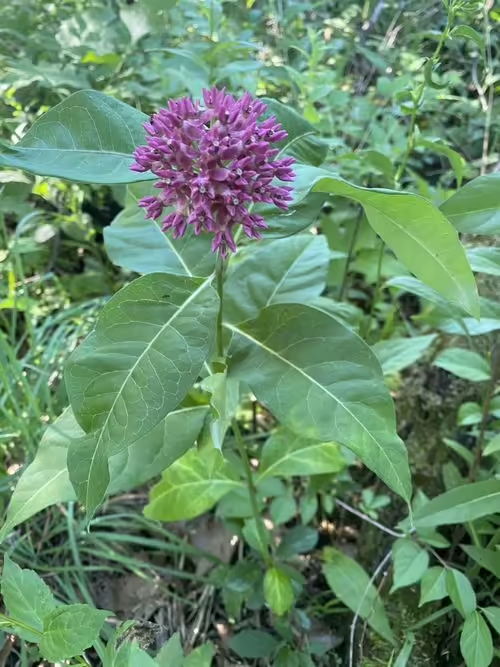
Facts about Purple Milkweed
- Native to Tennessee: Yes, rare in scattered counties mostly in central part of state (Kartesz 2015)
- Native to Johnson City: No, but is native in adjacent Greene County
- Natural Habitat: swamps, woodlands, meadows, and roadsides
- Height: up to 6 ft (1.8 m)
- Flower Color: purple, rose to pink, may mature to purple color
- Flowering Period: May to July
- USDA Hardiness Zone: 3-8
Gardening with Purple Milkweed
In your Johnson City, TN butterfly garden, this milkweed needs full sun to part-shade (more shade preferred) and moist well-drained soil. This species can also handle dry conditions.
7. Four-leaf Milkweed (Asclepias quadrifolia), a Milkweed for Dry Soils
If you have dry well-drained soils and some shade, this milkweed may be a good choice for you. In the wild, this species can be found growing in dry woodlands. Four-leaf milkweed has clusters of white to pink flowers and can be grown from seed or cuttings. Any place where this species is planted needs to be well-drained to prevent root rot.
Some companion plants to four-leaved milkweed that can grow in Johnson City in the same conditions and help maximize pollinator diversity include:
- Roundleaf Alumroot (Heuchera villosa): a plant with attractive foliage and pollinator attracting flowers that can grow in dry, rocky soils.
- Creeping Phlox (Phlox subulata): a plant that can grow in dry, rocky soils and produces carpet of flowers.
- Little Brown Jugs (Hexastylis arifolia): a groundcover similar to ginger that is pollinated by beetles and handles dry conditions.
- Mountain Mint (Pycanathemum spp.): a plant with fragrant leaves that grows in dry conditions and attracts pollinators.
- Early Saxifrage (Saxifraga virginiensis): a plant with early spring flowers that grows in dry, rocky soils.
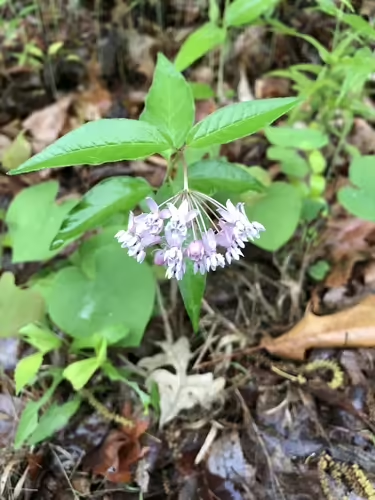
Facts about Four-leaved Milkweed
- Native to Tennessee: Yes, central and eastern counties (Kartesz 2015)
- Native to Johnson City: Yes
- Natural Habitat: open areas such as roadsides, pastures, and prairies that are dry and rocky, rarely in dense forest understories
- Height: 1 (0.3 m) to 3 ft (0.9 m)
- Flower Color: white (cream) to pink
- Flowering Period: April to July
- USDA Hardiness Zone: 5-8
Gardening with Four-leaved Milkweed
In your Johnson City, TN butterfly garden, this milkweed needs full sun to part-shade and dry well-drained soils.
8. Red Milkweed (Asclepias rubra), a Milkweed for Moist to Wet Soils
Another milkweed of moist soils, this milkweed is often found in full sun. However, in a garden setting it can be grown in medium soils. Soils, though, need to be consistently acidic. The small size could make this plant suitable for containers.
Some companion plants to red milkweed that can grow in Johnson City in the same conditions and help maximize pollinator diversity include:
- Highbush Blueberry (Vaccinum corymbosum): a shrub that grows in acidic and moist soils that attract pollinators and provide berries in the fall for wildlife.
- Swamp Rose (Rosa palustris): a native rose species that grows in acidic, moist soils, and has fragrant flowers.
- Buttonbush (Cephalanthus occidentalis): a shrub that is found in wet conditions and has white spherical flowers.
- Spicebush (Lindera benzoin): a shrub to small tree that likes moist, well-drained soil and hosts the spicebush swallowtail butterfly.
- Sweetbay Magnolia (Magnolia virginiana): another shrub that has white fragrant flowers and grows in acidic and moist soils.
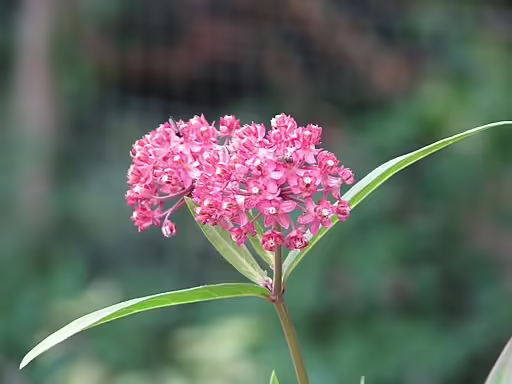
Facts about Red Milkweed
- Native to Tennessee: No (Kartesz 2015)
- Native to Johnson City: No
- Natural Habitat: bogs, meadows, and pine barrens
- Height: 1 ft (0.3 m) to 3 ft (0.9 m)
- Flower Color: pink, purple, red to lavender
- Flowering Period: May to August
- USDA Hardiness Zone: 6-9
Gardening with Red Milkweed
In your Johnson City, TN butterfly garden, this milkweed needs full sun to part-shade and wet organic soils.
9. Showy Milkweed (Asclepias speciosa), a Milkweed for Medium to Well-drained Soils
Showy milkweed is a commonly planted milkweed in butterfly gardens throughout the United States. It is a small to medium sized plant, making it suitable for containers, but whether planted or in a container, it needs good drainage. While not native to Tennessee or Johnson City, it can grow in the plant hardiness zone of the area.
Some companion plants to showy milkweed that can grow in Johnson City in the same conditions and help maximize pollinator diversity include:
- Priaire Dropseed (Sporobolus heterolepis): this grass species has fine-textured foliage and provide shelter for insects.
- Butterfly Weed (Asclepias tuberosa): another native milkweed species with orange flowers that can grow in the same conditions.
- Prairie Blazing Star (Liatris pycnostachya): a plant with tall, upright flower spikes that attract butterflies and bees.
- Stiff Goldenrod (Solidago rigida): a goldenrod that provides late-season blooms and attract pollinators.
- Prairie Phlox (Phlox pilosa): a phlox that has early season blooms and attracts pollinators.

Facts about Showy Milkweed
- Native to Tennessee: No (Kartesz 2015)
- Native to Johnson City: No
- Natural Habitat: roadsides, fields and woodlands
- Height: 1 ft (0.3 m) to 3 ft (0.9 m)
- Flower Color: purple to pink
- Flowering Period: April to June
- USDA Hardiness Zone: 3-9
Gardening with Showy Milkweed
In your Johnson City, TN butterfly garden, this milkweed needs full sun and medium to well-drained soil.
10. Common Milkweed (Asclepias syriaca), a Milkweed for all Conditions
This milkweed is one of the most common in the mid-west and northeastern United States. The large leaves provide ample feeding opportunities for monarch butterflies. Common milkweed is a plant for all conditions and can spread by seed or rhizomes, so it should have some space in the garden. To have the best flowering and it needs a lot of sunlight.
Some companion plants to common milkweed that can grow in Johnson City in the same conditions and help maximize pollinator diversity include:
- New England Aster (Symphyotrichum novae-angliae): this attractive purple aster can handle most soil conditions and is a pollinator magnet in the late summer and early fall.
- Oxeye Sunflower (Heliopsis helianthoides): this sunflower provides a yellow color contrast and attracts a number of pollinators.
- Culver’s Root (Veronicastrum virginicum): a plant with flower spikes that attract bees and butterflies and provides a contrasting visual interest.
- Wild Senna (Senna hebecarpa): a yellow flowering legume that attracts a number of pollinators and grows in varying soils conditions.
- Big Bluestem (Andropogon gerardii): a grass that can provide shelter for insects and visual interest.
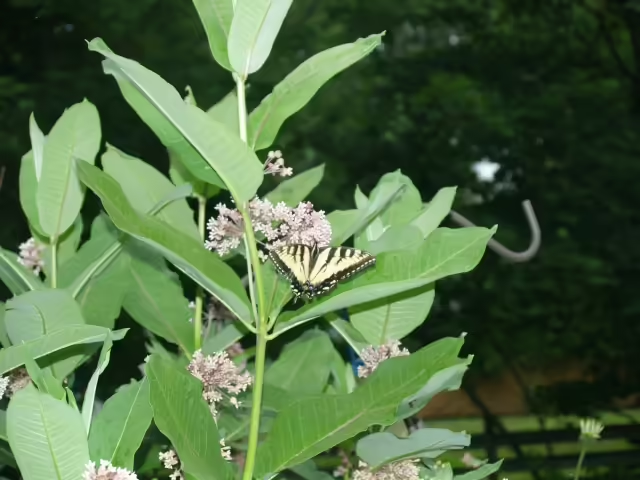
Facts about Common Milkweed
- Native to Tennessee: Yes, scattered throughout (Kartesz 2015)
- Native to Johnson City: Yes
- Natural Habitat: fields, pastures, roadsides
- Height: up to 6 ft (1.8 m)
- Flower Color: pink, greenish-purple, greenish-white, to white
- Flowering Period: June to August
- USDA Hardiness Zone: 3-9
Gardening with Common Milkweed
In your Johnson City, TN butterfly garden, this milkweed needs full sun to part shade and soils that are well-drained to occasionally dry.
11. Velvetleaf Milkweed (Asclepias tomentosa), a Milkweed for Medium to Dry Soils
This milkweed is native mostly to Florida and is of scattered distribution elsewhere in the United States. In the wild, velvetleaf milkweed grows in sandy pine woodlands with long-leaf pine (Pinus palustris) and scrub oak sandhills. Growing from 2 to 3 ft (0.6 to 1 m), it has flowers ranging from yellow-cream with pink to maroon tints that bloom from April to August.
Some companion plants to velvetleaf milkweed that can grow in Johnson City in the same conditions and help maximize pollinator diversity include:
- Sandhill Rosemary (Conradina vericillata): a plant that is rare in northeastern Tennessee that is fragrant and attract pollinators.
- Beardtongue (Penstemon spp.): a plant with tubular flowers that attracts hummingbirds and thrives in dry, sandy soils.
- Downy Phlox (Phlox pilosa): an early season blooming phlox that grows in dry soils.
- Prairie Coreopsis (Coreopsis palmata): a yellow flowering coreopsis that is tolerant of droughty conditions.
- Little Bluestem (Schizachyrium scoparium): a grass that provides structural diversity and shelter for insects.
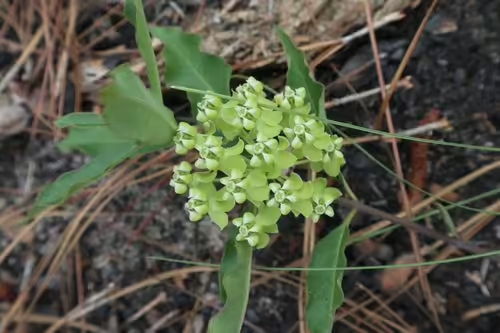
collected in United States of America
(licensed under CC0 1.0)
Facts about Velvet-leaf Milkweed
- Native to Tennessee: No (Kartesz 2015)
- Native to Johnson City: No
- Natural Habitat: sandy pine woodlands and scrub oak sandhills
- Height: 2 (0.6 m) to 3 ft (0.9 m)
- Flower Color: yellow-cream, green and/or with pink to maroon tints.
- Flowering Period: April to August
- USDA Hardiness Zone: 7-10
Gardening with Velvet-leaf Milkweed
In your Johnson City, TN butterfly garden, this milkweed needs full sun and soils that are medium to dry. This species may be a good long-term choice considering climate change induced warming. This plant may be difficult to locate in nurseries.
12. Butterfly Weed (Asclepias tuberosa), a Milkweed for all Conditions
Butterfly weed is one of three milkweeds in the United States that has an orange colored flower and is one of two that does not have a milky sap. It is one of the most commonly planted milkweeds in the on the east coast of the United States. In the wild, this milkweed grows in open areas with full sun such as fields, roadsides, and open woods. The orange flowers on this is plant are iconic and make it a favorite as well as its abilities to handle most garden conditions.
Some companion plants to butterfly weed that can grow in Johnson City in the same conditions and help maximize pollinator diversity include:
- Purple Coneflower (Echinacea purpurea): a plant that provides color contrast to the orange and attracts numerous pollinators.
- Sand Coreopsis (Coreopsis villosa): a yellow flowering coreopsis that grows in sandy soils.
- Downy Phlox (Phlox pilosa): an early season blooming phlox that grows in dry soils.
- Aromatic Aster (Symphyotrichum oblongifolium): an aster that provides late-season blooms and is a vital food source for butterflies.
- Little Bluestem (Schizachyrium scoparium): a grass that provides structural diversity and shelter for insects.

Facts about Butterfly Weed
Asclepias tuberosa subsp. interior and subsp. tuberosa in Tennessee
- Native to Tennessee: Yes, central and western counties – subsp. interior, eastern counties – subsp. tuberosa (Kartesz 2015)
- Native to Johnson City: No
- Natural Habitat: fields, roadsides and open woods
- Height: 1 ft (0.3 m) to 3 ft (0.9 m)
- Flower Color: orange
- Flowering Period: June to October
- USDA Hardiness Zone: 3-9
Gardening with Butterfly Weed
In your Johnson City, TN butterfly garden, this milkweed needs full sun and nearly any soil type.
13. Red-ring Milkweed (Asclepias variegata), a Milkweed for Medium to Moist Rich Soils
Red-ring milkweed an interesting flower that is white with a red or purple band. This makes the flower an interesting conversation piece and can be grown in full sun to part-shade and well-drained soils. In the wild, this milkweed is found open disturbed areas such as thickets and roadsides. Growing from 1 (0.3 m) to 4 ft (1.2 m), it blooms from May to July. Wherever it is grown, it needs shade during the hottest times of the day.
Some companion plants to red-ring milkweed that can grow in Johnson City in the same conditions and help maximize pollinator diversity include:
- Wild Ginger (Asarum canadense): ginger makes a nice groundcover plant and attracts early ground pollinators.
- Jacob’s Ladder (Polemonium reptans): this plant has blue flowers that attract bees and provides nice color contrast.
- Eastern Columbine (Aquilegia canadensis): this plant attracts hummingbirds and long-tongued bees.
- Solomon’s Seal (Polygonatum biflorum): This plant can grow in shaded areas and attracts pollinators.
- Virginia Bluebells (Mertensia virginica): Virginia bluebell is a nice spring ephemeral that provides blue flowers.
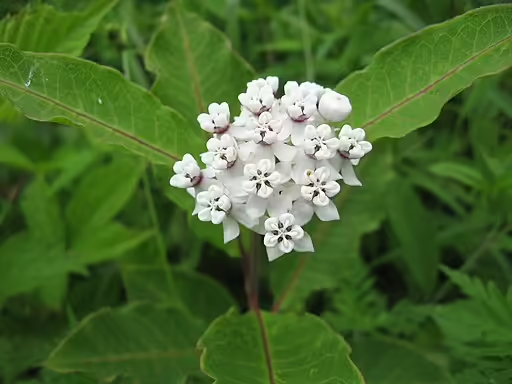
Facts about Red-ring Milkweed
- Native to Virginia: Yes, throughout, scattered in western counties (Kartesz 2015)
- Native to Johnson City: No
- Natural Habitat: thickets and roadsides
- Height: 1 ft (0.3 m) to 4 ft (1.2 m)
- Flower Color: white with a ring of purple to red at the base
- Flowering Period: May to July
- USDA Hardiness Zone: 3-9
Gardening with Red-ring Milkweed
In your Johnson City, TN butterfly garden, this milkweed needs part-sun to light-shade and moist to medium rich soils.
14. Whorled Milkweed (Asclepias verticillata), a Milkweed for Medium to Dry Soil
Whorled milkweed has narrow-leaves providing an interesting textual contrast to gardens. In the wild, whorled milkweed grows in open areas such as meadows and fields, where it can take advantage of full sun. Growing from 1 (0.3 m) to 3 (0.9 m) tall, it has green to white flowers that bloom from May to September. If you have average to dry soils and full sun to part-shade this species could live in your garden.
Some companion plants to whorled milkweed that can grow in Johnson City in the same conditions and help maximize pollinator diversity include:
- Prairie Coreopsis (Coreopsis palmata): a yellow flowering coreopsis that is tolerant of droughty conditions.
- Little Bluestem (Schizachyrium scoparium): a grass that provides structural diversity and shelter for insects.
- Aromatic Aster (Symphyotrichum oblongifolium): an aster that provides late-season blooms and is a vital food source for butterflies.
- Downy Phlox (Phlox pilosa): an early season blooming phlox that grows in dry soils.
- Mountain Mint (Pycanathemum spp.): a plant with fragrant leaves that grows in dry conditions and attracts pollinators.

Facts about Whorled Milkweed
- Native to Tennessee: Yes, scattered throughout (Kartesz 2015)
- Native to Johnson City: No
- Natural Habitat: meadows and fields
- Height: 1 ft (0.3 m) to 3 ft (0.9 m)
- Flower Color: green to white flowers
- Flowering Period: May to September
- USDA Hardiness Zone: 3-9
Gardening with Whorled Milkweed
In your Johnson City, TN butterfly garden, this milkweed needs full sun to part-shade and medium to dry soil.
15. Green Comet Milkweed (Asclepias viridiflora), a Milkweed for Medium to Dry Sandy Soils
Green comet milkweed is a milkweed having two different flower colors depending on the age. When young the flowers are green, but with age they become yellow. In the wild, green comet milkweed grows in open areas such as meadows and fields where there is full sun. Thriving in full sun to part shade and average to dry sandy soils, this could be an excellent addition to your garden and provide leafy interest.
Some companion plants to green comet milkweed that can grow in Johnson City in the same conditions and help maximize pollinator diversity include:
- Prairie Coreopsis (Coreopsis palmata): a yellow flowering coreopsis that is tolerant of droughty conditions.
- Little Bluestem (Schizachyrium scoparium): a grass that provides structural diversity and shelter for insects.
- Aromatic Aster (Symphyotrichum oblongifolium): an aster that provides late-season blooms and is a vital food source for butterflies.
- Downy Phlox (Phlox pilosa): an early season blooming phlox that grows in dry soils.
- Mountain Mint (Pycanathemum spp.): a plant with fragrant leaves that grows in dry conditions and attracts pollinators.

Facts about Green Comet Milkweed
- Native to Tennessee: Yes, scattered throughout (Kartesz 2015)
- Native to Johnson City: No
- Natural Habitat: meadows and fields
- Height: 1 ft (0.3 m) to 3 ft (0.9 m)
- Flower Color: green, aging to yellow with a purple tinge
- Flowering Period: June to August
- USDA Hardiness Zone: 3-9
Gardening with Green Comet Milkweed
In your Johnson City, TN butterfly garden, this milkweed needs full sun to part-shade and medium to dry soil.
16. Green Milkweed (Asclepias viridis), a Milkweed for Medium to Dry High pH Soils
Green milkweed, as the name would imply has green to yellowish-green flowers, that can also be white. In the wild, green milkweed grows in open areas such as glades, prairies, dry hillsides, roadsides, pastures, and dry woodlands. The plants grow from 0.5 (0.2 m) to 2 feet (0.6 m) tall and flower from April to October. This plant grows best in medium to dry soils that are high in pH.
Some companion plants to green milkweed that can grow in Johnson City in the same conditions and help maximize pollinator diversity include:
- Prairie Coreopsis (Coreopsis palmata): a yellow flowering coreopsis that is tolerant of droughty conditions.
- Little Bluestem (Schizachyrium scoparium): a grass that provides structural diversity and shelter for insects.
- Aromatic Aster (Symphyotrichum oblongifolium): an aster that provides late-season blooms and is a vital food source for butterflies.
- Downy Phlox (Phlox pilosa): an early season blooming phlox that grows in dry soils.
- Mountain Mint (Pycanathemum spp.): a plant with fragrant leaves that grows in dry conditions and attracts pollinators.

observed in United States of America
by Alan Prather (licensed under CC BY 4.0)
Facts about Green Milkweed
- Native to Tennessee: Yes, limited central and southeastern counties (Kartesz 2015)
- Native to Johnson City: No
- Natural Habitat: open areas with high pH soils
- Height: 0.5 ft (0.2 m) to 2 ft (0.6 m)
- Flower Color: green, yellowish-green to white
- Flowering Period: April to October
- USDA Hardiness Zone: 5-9
Gardening with Green Milkweed
In your Johnson City, TN butterfly garden, this milkweed needs full sun and medium to dry soil, high pH soils.
When selecting your Johnson City, TN milkweed, make sure that it grows in your zone and habitat.
Books where you can find out more about Monarchs and Butterfly Gardening in Johnston City, TN
- Daniels, Jaret C. 2021. Butterflies of the South & Southeast – Your Way to Easily Identify Butterflies – Adventure Quick Guides. Adventure Publications.22 pp.
- Daniels, Jaret C. 2021. Garden Bugs & Insects of the South & Southeast – Identify Pollinators, Pests, and Other Garden Visitors – Adventure Quick Guides. Adventure Publications. 36 pp.
- Daniels, Jaret C. 2021. Native Plant Gardening for Birds, Bees & Butterflies. Southeast – Nature Friendly Gardens. Adventure Publications. 276 pp.
- Frick-Ruppert, Jennifer. 2010. Mountain Nature – A Seasonal Natural History of the Southern Appalachians. The University of North Carolina Press. 224 pp.
- Mellichamp, Larry, Paula Gross, and Will Stuart. 2020. The Southeast Native Plant Primer – 225 Plants for an Earth-Friendly Garden. Timber Press. 256 pp.
Affiliate Disclosure: When you click on links to various merchants on this site and make a purchase, this site can earn a commission at no extra cost to you. Affiliate programs include, but are not limited to, the eBay Partner Network and Blackwell’s Books.
References for Johnson City, TN Milkweeds
- Urguhart, Fredrick Albert, Norah Roden Urguhart, and Francis Munger. 1968. Population of Danaus plexippus in Southern California. Journal of Research on the Lepidoptera 7(4): 169-181.
- Woodson, Robert E. 1954. The North American Species of Asclepias L. Annals of the Missouri Botanical Garden 41: 1-211.